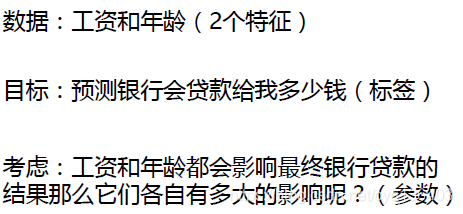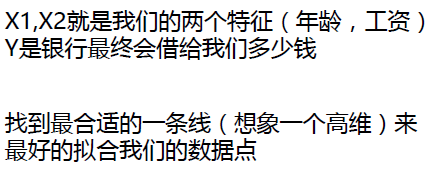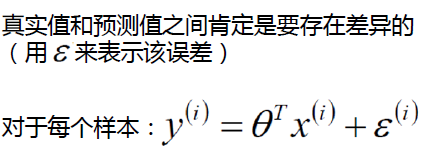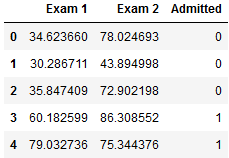梯度下降求解逻辑回归
来自唐宇迪——机器学习视频课的笔记。
Logistic Regression 逻辑回归
首先先看一下理论部分:











梯度下降:
引入:当我们得到了一个目标函数后,如何进行求解?
直接求解?(并不一定可解,线性回归可以当作是一个特例)
常规套路:机器学习的套路就是交给机器一堆数据,然后告诉它什么样的学习方式是对的(目标函数),然后让它朝着这个方向去做。
如何优化:一步步地完成迭代。(每次优化一点点,积累起来就相当精确了,一般是10000次或者100000次。)
 m为样本数。
m为样本数。

小批量梯度下降法中的系数
α
1
10
\alpha {1\over10}
α101?就是批处理数量为10。
我们现在最常用的就是小批量梯度下降法。

学习率一般取0.01,不行就再小。
批处理数量根据内存,能多大就多大,越大结果越精确,目前一般是64。






下面开始正篇,代码部分:
数据为.txt文件:LogiReg_data.txt,大家可以从我的百度网盘直接下载:
链接:https://pan.baidu.com/s/1D5jS_DTGmU1t3ZrHR8tlvw
提取码:2222
首先是数据和模型描述:
我们将建立一个逻辑回归模型来预测一个学生是否被大学录取。假设你是一个大学系的管理员,你想根据两次考试的结果来决定每个申请人的录取机会。你有以前的申请人的历史数据,你可以用它作为逻辑回归的训练集。对于每一个培训例子,你有两个考试的申请人的分数和录取决定。为了做到这一点,我们将建立一个分类模型,根据考试成绩估计入学概率。
先对数据进行初步分析:
#三大件
import numpy as np
import pandas as pd
import matplotlib.pyplot as plt
%matplotlib inline
import os
os.chdir(r'C:\Users\Administrator\Desktop\python数据分析与机器学习实战\自己的学习资料\数据文件')
# path = 'data' + os.sep + 'LogiReg_data.txt'也可以用path方法读入
pdData = pd.read_csv('LogiReg_data.txt', header=None, names=['Exam 1', 'Exam 2', 'Admitted'])
pdData.head()
这边数据的第一行直接就是是样本,所以我们要先指定header为none值,然后再重命名列名,exam1是第一次考试成绩,exam2是第二次考试成绩,admitted是是否被录取。

pdData.shape
看一下数据的维度。
(100, 3)
positive = pdData[pdData['Admitted'] == 1] # returns the subset of rows such Admitted = 1, i.e. the set of *positive* examples
negative = pdData[pdData['Admitted'] == 0] # returns the subset of rows such Admitted = 0, i.e. the set of *negative* examples
fig, ax = plt.subplots(figsize=(10,5))
ax.scatter(positive['Exam 1'], positive['Exam 2'], s=30, c='b', marker='o', label='Admitted')
ax.scatter(negative['Exam 1'], negative['Exam 2'], s=30, c='r', marker='x', label='Not Admitted')
ax.legend()
ax.set_xlabel('Exam 1 Score')
ax.set_ylabel('Exam 2 Score')
指定正例为录取的,即admitted为1的样本,负例为未录取的,即admitted为0的样本。

接下来我们来实现算法:
The logistic regression
目标:建立分类器(求解出三个参数 𝜃0 𝜃1 𝜃2)
设定阈值,根据阈值判断录取结果。
如果设为0.5,则大于0.5被录取,小于0.5未被录取。
要完成的模块
sigmoid : 映射到概率的函数
model : 返回预测结果值
cost : 根据参数计算损失
gradient : 计算每个参数的梯度方向
descent : 进行参数更新
accuracy: 计算精度
先写sigmoid函数:
S i g m o i d 函 数 的 定 义 域 与 值 域 : g : R → [ 0 , 1 ] ; g ( 0 ) = 0.5 ; g ( ? ∞ ) = 0 ; g ( + ∞ ) = 1 Sigmoid函数的定义域与值域:g:R→[0,1];g(0)=0.5;g(-\infty)=0;g(+\infty)=1 Sigmoid函数的定义域与值域:g:R→[0,1];g(0)=0.5;g(?∞)=0;g(+∞)=1
def sigmoid(z):
return 1 / (1 + np.exp(-z))
nums = np.arange(-10, 10, step=1) #creates a vector containing 20 equally spaced values from -10 to 10
fig, ax = plt.subplots(figsize=(12,4))
ax.plot(nums, sigmoid(nums), 'r')

下面写预测函数,即model函数:
def model(X, theta):
""" Returns our model result
:param X: examples to classify, n x p
:param theta: parameters, 1 x p
:return: the sigmoid evaluated for each examples in X given parameters theta as a n x 1 vector
"""
return sigmoid(np.dot(X, theta.T))

# 注意,这个只能运行一次,第二次就会报错,因为已经存在了,就报错
pdData.insert(0, 'Ones', 1) # in a try / except structure so as not to return an error if the block si executed several times 注意,这个只能运行一次,第二次就会报错,因为已经存在了,就报错
pdData
# set X (training data) and y (target variable)
# orig_data = pdData.as_matrix() # convert the Pandas representation of the data to an array useful for further computations,新版本中没有 as_matrix
orig_data = pdData.values # 新版本中用这个代替上面的 as_matrix
cols = orig_data.shape[1]
X = orig_data[:,0:cols-1]
y = orig_data[:,cols-1:cols]
# convert to numpy arrays and initalize the parameter array theta
#X = np.matrix(X.values)
#y = np.matrix(data.iloc[:,3:4].values) #np.array(y.vales)
theta = np.zeros([1, 3])
首先我们要添加都是1的一列,构造出 [ 1 , x 1 , x 2 ] T [1,x_1,x_2]^T [1,x1?,x2?]T
然后再构造一个[θ1,θ2,θ3],但是我们现在不关心[θ1,θ2,θ3]里面的值,所以用0占位。
X[:5]
X的前5行:
array([[ 1. , 34.62365962, 78.02469282],
[ 1. , 30.28671077, 43.89499752],
[ 1. , 35.84740877, 72.90219803],
[ 1. , 60.18259939, 86.3085521 ],
[ 1. , 79.03273605, 75.34437644]])
y[:5]
y的前5列:
array([[0.],
[0.],
[0.],
[1.],
[1.]])
theta
array([[0., 0., 0.]])
X.shape, y.shape, theta.shape
((100, 3), (100, 1), (1, 3))
下面写损失函数,即cost函数:

def cost(X, y, theta):
left = np.multiply(-y, np.log(model(X, theta)))
right = np.multiply(1 - y, np.log(1 - model(X, theta)))
return np.sum(left - right) / (len(X))
cost(X, y, theta)
0.6931471805599453
先试一下能不能运行出来,这里损失值有些大,不过没有关系。
下面写梯度计算公式,即gradient函数:

def gradient(X, y, theta):
grad = np.zeros(theta.shape)
error = (model(X, theta)- y).ravel()
for j in range(len(theta.ravel())): #for each parmeter
term = np.multiply(error, X[:,j])
grad[0, j] = np.sum(term) / len(X)
return grad
这一步对梯度的求解是最难的部分,这个for循环需要好好体会。
Gradient descent
我们要比较3种不同梯度下降方法:批量/整体(整体梯度下降也叫直接梯度下降)、随机(SGD)、小批量(Mini-batch)在不同学习率,不同迭代次数下的结果。
首先,在这三种梯度下降方法下,我们还要指定一个停止策略,即迭代几次后停止。
我们有3种停止策略:
第一种停止策略:根据迭代次数进行停止。更新一次参数就是一次迭代,达到我们设定的指定迭代次数,我们就停止。
第二种停止策略:根据损失进行停止。迭代前和迭代后的损失目标函数如果没有太大变化,我们就停止。
第三种停止策略:根据梯度进行停止。迭代前和迭代后的梯度如果没有太大变化,我们就停止。
下面写停止策略函数,即stopCriterion函数:
STOP_ITER = 0
STOP_COST = 1
STOP_GRAD = 2
def stopCriterion(type, value, threshold):
#设定三种不同的停止策略
if type == STOP_ITER: return value > threshold
elif type == STOP_COST: return abs(value[-1]-value[-2]) < threshold
elif type == STOP_GRAD: return np.linalg.norm(value) < threshold
为了使我们的模型泛化能力更强,所以我们首先要打乱数据:
import numpy.random
#洗牌
def shuffleData(data):
np.random.shuffle(data)
cols = data.shape[1]
X = data[:, 0:cols-1]
y = data[:, cols-1:]
return X, y
不同梯度下降策略消耗的时间对结果的影响:
参数解释:
batchsize=1:随机梯度下降
batchsize=总样本数:直接梯度下降
1 < batchsize < 总样本数:mini-batch
stoptype:停止策略
thresh:策略对应的阈值
alpha:学习率
import time
def descent(data, theta, batchSize, stopType, thresh, alpha):
#梯度下降求解
#初始化
init_time = time.time()
i = 0 # 迭代次数
k = 0 # batch
X, y = shuffleData(data)
grad = np.zeros(theta.shape) # 计算的梯度
costs = [cost(X, y, theta)] # 损失值
#计算cost损失值
while True:
grad = gradient(X[k:k+batchSize], y[k:k+batchSize], theta)
k += batchSize #取batch数量个数据
if k >= n:
k = 0
X, y = shuffleData(data) #重新洗牌
theta = theta - alpha*grad # 参数更新
costs.append(cost(X, y, theta)) # 计算新的损失
i += 1
#选择不同的停止策略
if stopType == STOP_ITER: value = i
elif stopType == STOP_COST: value = costs
elif stopType == STOP_GRAD: value = grad
#到了停止条件我们就跳出循环
if stopCriterion(stopType, value, thresh): break
return theta, i-1, costs, grad, time.time() - init_time
def runExpe(data, theta, batchSize, stopType, thresh, alpha):
#import pdb; pdb.set_trace();
#这一步是核心求解
theta, iter, costs, grad, dur = descent(data, theta, batchSize, stopType, thresh, alpha)
#下面是展示用的辅助函数
#根据不同的梯度下降和停止策略选择策略的名字
name = "Original" if (data[:,1]>2).sum() > 1 else "Scaled"
name += " data - learning rate: {} - ".format(alpha)
if batchSize==n: strDescType = "Gradient"
elif batchSize==1: strDescType = "Stochastic"
else: strDescType = "Mini-batch ({})".format(batchSize)
name += strDescType + " descent - Stop: "
if stopType == STOP_ITER: strStop = "{} iterations".format(thresh)
elif stopType == STOP_COST: strStop = "costs change < {}".format(thresh)
else: strStop = "gradient norm < {}".format(thresh)
name += strStop
#显示在图上
print ("***{}\nTheta: {} - Iter: {} - Last cost: {:03.2f} - Duration: {:03.2f}s".format(
name, theta, iter, costs[-1], dur))
fig, ax = plt.subplots(figsize=(12,4))
ax.plot(np.arange(len(costs)), costs, 'r')
ax.set_xlabel('Iterations')
ax.set_ylabel('Cost')
ax.set_title(name.upper() + ' - Error vs. Iteration')
return theta
不同的停止策略:
1、设定迭代次数
#选择的梯度下降方法是基于所有样本的
n=100
runExpe(orig_data, theta, n, STOP_ITER, thresh=5000, alpha=0.000001)

2、根据损失值停止
设
定
阈
值
1
?
6
,
差
不
多
需
要
110000
次
迭
代
。
设定阈值 1^{-6}, 差不多需要110 000次迭代。
设定阈值1?6,差不多需要110000次迭代。
runExpe(orig_data, theta, n, STOP_COST, thresh=0.000001, alpha=0.001)

3、根据梯度变化停止
设定阈值 0.05,差不多需要40 000次迭代。
runExpe(orig_data, theta, n, STOP_GRAD, thresh=0.05, alpha=0.001)

对比不同的梯度下降方法
Stochastic descent
只迭代一个样本:
runExpe(orig_data, theta, 1, STOP_ITER, thresh=5000, alpha=0.001)

有点爆炸…很不稳定(结果是不会收敛的),再来试试把学习率调小一些。
下面我们把迭代次数增多,学习率调小:
runExpe(orig_data, theta, 1, STOP_ITER, thresh=15000, alpha=0.000002)

速度快,但稳定性差(收敛结果还是不尽人意),需要很小的学习率。
Mini-batch descent
一次迭代拿16个样本:
runExpe(orig_data, theta, 16, STOP_ITER, thresh=15000, alpha=0.001)

浮动仍然比较大,我们来尝试下对数据进行标准化,将数据按其属性(按列进行)减去其均值,然后除以其方差。
最后得到的结果是,对每个属性/每列来说所有数据都聚集在0附近,方差值为1。
from sklearn import preprocessing as pp
scaled_data = orig_data.copy()
scaled_data[:, 1:3] = pp.scale(orig_data[:, 1:3])
runExpe(scaled_data, theta, n, STOP_ITER, thresh=5000, alpha=0.001)

原始数据,只能达到0.61,而我们这里得到了0.38,结果明显改善。
所以我们遇到浮动比较大的情形时,先对数据下手,对数据做预处理是非常重要的。
先改数据,不行再改模型,是我们的基本套路。
进一步改进:
runExpe(scaled_data, theta, n, STOP_GRAD, thresh=0.02, alpha=0.001)

更多的迭代次数会使得损失下降的更多。
theta = runExpe(scaled_data, theta, 1, STOP_GRAD, thresh=0.002/5, alpha=0.001)

随机梯度下降更快,但是我们需要迭代的次数也需要更多,所以还是用mini-batch比较合适。
使用预处理后的数据scaled_data,样本取16,在迭代次数比较少,学习率较小的情况下结果还是不错的:
runExpe(scaled_data, theta, 16, STOP_GRAD, thresh=0.002*2, alpha=0.001)

精度
把之前结果中的概率值转换成类别值(0或1):
#设定阈值
def predict(X, theta):
return [1 if x >= 0.5 else 0 for x in model(X, theta)]
预测对了几个?
scaled_X = scaled_data[:, :3]
y = scaled_data[:, 3]
predictions = predict(scaled_X, theta)
correct = [1 if ((a == 1 and b == 1) or (a == 0 and b == 0)) else 0 for (a, b) in zip(predictions, y)]
accuracy = (sum(map(int, correct)) % len(correct))
print ('accuracy = {0}%'.format(accuracy))
accuracy = 89%